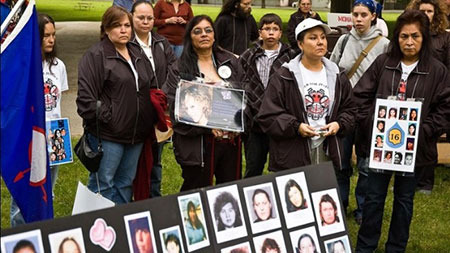
“The gap between the poorest and the wealthiest around the world is wide and growing. … We must do more to empower individuals through decent work, support people through social protection, and ensure the voices of the poor and marginalised are heard.”
United Nations Secretary-General Ban Ki-moon
Message for the 2014 World Day of Social Justice (1)
“Social justice is an underlying principle for peaceful and prosperous coexistence within and among nations. We uphold the principles of social justice when we promote gender equality or the rights of indigenous peoples and migrants”. (2).
In late 2013, the Commissioner of the RCMP initiated an RCMP-led study of reported incidents of missing and murdered Aboriginal women across all police jurisdictions in Canada. Police-recorded incidents of Aboriginal female homicides and unresolved missing Aboriginal females in this review total 1,181 – 164 missing and 1,017 homicide victims.
There are 225 unsolved cases of either missing or murdered Aboriginal females:105 missing for more than 30 days as of November 4, 2013, whose cause of disappearance was categorized at the time as “unknown” or “foul play suspected” and 120 unsolved homicides between 1980 and 2012.The total indicates that Aboriginal women are over-represented among Canada’s murdered and missing women. (3)
A report released on January 12, 2015 by the Inter-American Commission on Human Rights adds further weight to calls for a comprehensive national response to violence against Indigenous women and girls, including an independent public inquiry. (4)
According to a Committee Report on the Root Causes of Violence and Violence Prevention by the Parliament of Canada “The high levels of poverty and lack of housing limit the options available to women experiencing violence. Women are sometimes forced to stay with an abusive partner because they have nowhere else to go. “
The Committee has heard that those who leave their communities, or leave an abusive household sometimes find themselves homeless, or forced into the sex trade.
Additionally, as a result of their collective experience with the residential school system, there is a high level of distrust between Aboriginal people and services such as the child welfare system and police forces. As a result, Aboriginal women and girls may not benefit from the level of prevention services which would be warranted by their high level of vulnerability to violence.
The findings of the Committee are consistent with other documented findings related to the way that systems and services are failing Aboriginal women and girls and making them more vulnerable to violence. (5)
The report released on January 12, 2015 by the Inter-American Commission on Human Rights further states that a “failure to act with due diligence with respect to cases of violence against women is a form of discrimination. The lack of due diligence in cases of violence against indigenous women is especially grave as it affects not only the victims, but also their families and the communities to which they belong.”
The report urges governments in Canada to deal with “the persistence of longstanding social and economic marginalization through effective measures to combat poverty, improve education and employment, guarantee adequate housing and address the disproportionate application of criminal law against indigenous people.”
The Commission is also critical of governments in Canada for failing to adequately involve Indigenous women and Indigenous women’s organizations in developing solutions to the human rights violations that they face. (4)
An article in the Toronto Star on Wednesday February 15, 2015 reports that : ”The Conservative government has resisted calls for a national public inquiry, but last fall put forward a $25-million action plan on violence against aboriginal women and girls. (6)
According to the United Nations article on World Day of Social Justice, “We advance social justice when we remove barriers that people face because of gender, age, race, ethnicity, religion, culture or disability.
Observance of World Day of Social Justice should support efforts of the international community in poverty eradication, the promotion of full employment and decent work, gender equity and access to social well-being and justice for all.” (1)
Reference Sources:
(1) Secretary-General’s Message for 2014 http://www.un.org/en/events/socialjusticeday/2014/sgmessage.shtml
(2) World Day of Social Justice http://www.un.org/en/events/socialjusticeday/
(3) Missing & murdered Aboriginal Women: A National Operational Overview
http://www.rcmp-grc.gc.ca/pubs/mmaw-faapd-eng.pdf
(4) Regional human rights body condemns Canada’s failure to address crisis of missing and murdered Indigenous women
http://www.amnesty.ca/news/public-statements/regional-human-rights-body-condemns-canada%E2%80%99s-failure-to-address-crisis-of
(5) Parliament of Canada, Committee Report, Chapter Three: Root Causes of Violence and Violence Prevention
http://www.parl.gc.ca/HousePublications/Publication.aspx?DocId=6469851&File=48#6
(6) Toronto Star Article, Wed Feb 15,2015: Activists hope international group’s report will lead to action on aboriginal women
http://www.thestar.com/news/canada/2015/01/12/advocates_hope_report_into_missing_and_murdered_aboriginal_women_will_pressure_ottawa_into_action.html



